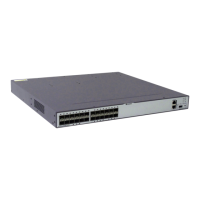The filter-policy is configured in the RIP process. If routes are filtered based on an interface,
you can configure only one route-policy based on the interface at a time. If no interface is
specified, the system considers the configured route-policy as the global route-policy, and you
can configure only one route-policy at a time. If the route-policy is configured repeatedly, the
new route-policy will replace the old route-policy.
----End
10.6.3 Filtering Routes Advertised by OSPF
By applying filters, you can control the advertisement of OSPF routes.
Context
Do as follows on the switch that runs OSPF:
Procedure
Step 1 Run:
system-view
The system view is displayed.
Step 2 Run:
ospf [ process-id ]
An OSPF process is enabled and the OSPF view is displayed.
Step 3 Run:
filter-policy { acl-number | acl-name acl-name | ip-prefix ip-prefix-name } export
[ protocol [ process-id ] ]
The filtering policy is configured to filter the imported routes when these routes are advertised
by OSPF.
----End
10.6.4 Filtering Routes Advertised by IS-IS
By applying filters, you can control the advertisement of IS-IS routes.
Context
Do as follows on the switch that runs IS-IS:
Procedure
Step 1 Run:
system-view
The system view is displayed.
Step 2 Run:
isis [ process-id ]
An IS-IS process is enabled and the IS-IS view is displayed.
S6700 Series Ethernet Switches
Configuration Guide - IP Routing 10 Routing Policy Configuration
Issue 01 (2012-03-15) Huawei Proprietary and Confidential
Copyright © Huawei Technologies Co., Ltd.
608

